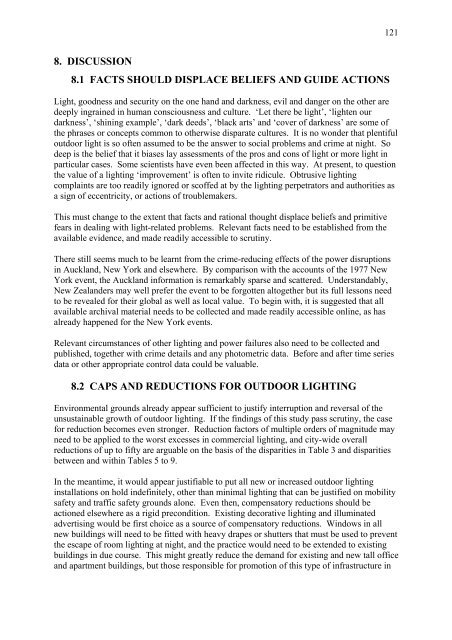Outdoor Lighting and Crime - Amper
Outdoor Lighting and Crime - Amper
Outdoor Lighting and Crime - Amper
You also want an ePaper? Increase the reach of your titles
YUMPU automatically turns print PDFs into web optimized ePapers that Google loves.
8. DISCUSSION<br />
8.1 FACTS SHOULD DISPLACE BELIEFS AND GUIDE ACTIONS<br />
Light, goodness <strong>and</strong> security on the one h<strong>and</strong> <strong>and</strong> darkness, evil <strong>and</strong> danger on the other are<br />
deeply ingrained in human consciousness <strong>and</strong> culture. ‘Let there be light’, ‘lighten our<br />
darkness’, ‘shining example’, ‘dark deeds’, ‘black arts’ <strong>and</strong> ‘cover of darkness’ are some of<br />
the phrases or concepts common to otherwise disparate cultures. It is no wonder that plentiful<br />
outdoor light is so often assumed to be the answer to social problems <strong>and</strong> crime at night. So<br />
deep is the belief that it biases lay assessments of the pros <strong>and</strong> cons of light or more light in<br />
particular cases. Some scientists have even been affected in this way. At present, to question<br />
the value of a lighting ‘improvement’ is often to invite ridicule. Obtrusive lighting<br />
complaints are too readily ignored or scoffed at by the lighting perpetrators <strong>and</strong> authorities as<br />
a sign of eccentricity, or actions of troublemakers.<br />
This must change to the extent that facts <strong>and</strong> rational thought displace beliefs <strong>and</strong> primitive<br />
fears in dealing with light-related problems. Relevant facts need to be established from the<br />
available evidence, <strong>and</strong> made readily accessible to scrutiny.<br />
There still seems much to be learnt from the crime-reducing effects of the power disruptions<br />
in Auckl<strong>and</strong>, New York <strong>and</strong> elsewhere. By comparison with the accounts of the 1977 New<br />
York event, the Auckl<strong>and</strong> information is remarkably sparse <strong>and</strong> scattered. Underst<strong>and</strong>ably,<br />
New Zeal<strong>and</strong>ers may well prefer the event to be forgotten altogether but its full lessons need<br />
to be revealed for their global as well as local value. To begin with, it is suggested that all<br />
available archival material needs to be collected <strong>and</strong> made readily accessible online, as has<br />
already happened for the New York events.<br />
Relevant circumstances of other lighting <strong>and</strong> power failures also need to be collected <strong>and</strong><br />
published, together with crime details <strong>and</strong> any photometric data. Before <strong>and</strong> after time series<br />
data or other appropriate control data could be valuable.<br />
8.2 CAPS AND REDUCTIONS FOR OUTDOOR LIGHTING<br />
Environmental grounds already appear sufficient to justify interruption <strong>and</strong> reversal of the<br />
unsustainable growth of outdoor lighting. If the findings of this study pass scrutiny, the case<br />
for reduction becomes even stronger. Reduction factors of multiple orders of magnitude may<br />
need to be applied to the worst excesses in commercial lighting, <strong>and</strong> city-wide overall<br />
reductions of up to fifty are arguable on the basis of the disparities in Table 3 <strong>and</strong> disparities<br />
between <strong>and</strong> within Tables 5 to 9.<br />
In the meantime, it would appear justifiable to put all new or increased outdoor lighting<br />
installations on hold indefinitely, other than minimal lighting that can be justified on mobility<br />
safety <strong>and</strong> traffic safety grounds alone. Even then, compensatory reductions should be<br />
actioned elsewhere as a rigid precondition. Existing decorative lighting <strong>and</strong> illuminated<br />
advertising would be first choice as a source of compensatory reductions. Windows in all<br />
new buildings will need to be fitted with heavy drapes or shutters that must be used to prevent<br />
the escape of room lighting at night, <strong>and</strong> the practice would need to be extended to existing<br />
buildings in due course. This might greatly reduce the dem<strong>and</strong> for existing <strong>and</strong> new tall office<br />
<strong>and</strong> apartment buildings, but those responsible for promotion of this type of infrastructure in<br />
121
















